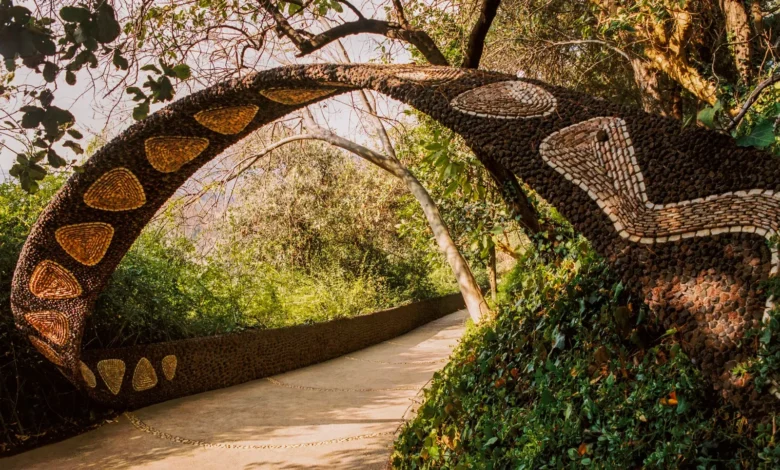El Nido de Quetzalcóatl: A Surreal Haven in the Heart of Mexico

Introduction to El Nido de Quetzalcóatl
Nestled in the lush outskirts of Naucalpan, Mexico, El Nido de Quetzalcóatl is a masterpiece of modern architecture and natural harmony. The name, which translates to “The Nest of Quetzalcóatl,” draws inspiration from the Aztec deity of wind, air, and learning. This unique creation blurs the line between fantasy and reality, offering visitors an immersive experience that feels almost otherworldly.
Designed by the visionary Mexican architect Javier Senosiain, El Nido de Quetzalcóatl is a testament to organic architecture. This movement emphasizes the seamless integration of structures into their natural surroundings. The estate spans an impressive five hectares and includes a series of undulating structures that mimic the sinuous forms of nature. From afar, it resembles a giant serpent—a fitting homage to its namesake deity.
Visiting this location is not just about marveling at its architecture. It’s an opportunity to explore a space that encourages a deeper connection with nature, all while experiencing cutting-edge design. Whether you’re an architecture enthusiast or simply a curious traveler, this site offers something extraordinary.
The Vision Behind the Creation
The story of El Nido de Quetzalcóatl begins with the dream of creating a space where nature and human innovation coexist. Javier Senosiain’s philosophy of organic architecture drives this vision. He believes in designing buildings that mimic natural forms and function harmoniously within their environments. This ideology manifests vividly in this remarkable site.
Constructed in the late 1990s and early 2000s, El Nido de Quetzalcóatl’s development was no easy feat. Senosiain transformed a challenging terrain—a naturally occurring cave and ravine—into an architectural wonder. The estate’s design ensures minimal disruption to the land, preserving its ecological integrity. This commitment to environmental preservation sets the project apart as a sustainable marvel in a world where urban development often comes at nature’s expense.
The design’s central theme revolves around Quetzalcóatl, a deity often depicted as a feathered serpent. The serpent’s form is mirrored in the flowing lines and curves of the buildings, with each section evoking a sense of movement and life. By merging cultural heritage with modern design principles, the estate celebrates Mexico’s rich history while pushing the boundaries of contemporary architecture.
Exploring the Architecture
The architectural design of El Nido de Quetzalcóatl is nothing short of mesmerizing. Its central feature—a massive serpentine structure—immediately captures attention. This structure serves as both a visual focal point and a functional element, housing a series of interconnected living spaces. Each section is uniquely designed, offering a blend of privacy and openness that enhances the visitor’s experience.
The serpent’s “head” is one of the most striking elements of the design. With vibrant mosaics and intricate detailing, it embodies the spirit of Quetzalcóatl in both form and symbolism. The interiors are equally captivating, featuring organic shapes, earthy tones, and natural materials that echo the surrounding environment. Large windows and skylights allow sunlight to flood the spaces, creating a warm and inviting atmosphere.
Outside, the landscape is meticulously curated to complement the architectural forms. Native plants, flowing water features, and winding pathways create an almost mythical setting. The interplay between architecture and nature is seamless, making it difficult to distinguish where one ends and the other begins. This harmony invites visitors to lose themselves in the beauty of the surroundings while exploring every corner of the estate.
Living in Harmony with Nature
One of the core principles behind El Nido de Quetzalcóatl is the idea of living in harmony with nature. The estate’s design goes beyond aesthetics, incorporating sustainable practices that reduce its environmental impact. Rainwater harvesting systems, natural ventilation, and the use of locally sourced materials are just a few examples of how sustainability is woven into the fabric of the project.
The gardens surrounding the estate are more than just decorative. They are carefully cultivated ecosystems that support local wildlife, including birds, insects, and small mammals. By preserving and enhancing the natural environment, the project fosters biodiversity and creates a sanctuary for native species. This commitment to ecological balance underscores the importance of coexisting with nature in an increasingly urbanized world.
Visitors often describe a sense of peace and connection when exploring the site. The undulating shapes and natural materials evoke a feeling of being embraced by the earth itself. This sensory experience is a reminder of the profound impact that thoughtful design can have on our well-being and our relationship with the environment.
Cultural Significance and Inspiration
El Nido de Quetzalcóatl is deeply rooted in Mexican culture and mythology. Quetzalcóatl, the feathered serpent god, is a prominent figure in Mesoamerican belief systems. As a symbol of duality and balance, Quetzalcóatl represents the fusion of opposites—earth and sky, human and divine. This theme of unity is evident throughout the estate’s design.
The use of vibrant colors and intricate patterns pays homage to traditional Mexican art forms. Mosaic tiles, hand-painted details, and natural textures reflect the rich cultural heritage of the region. These elements not only enhance the visual appeal of the estate but also connect visitors to the stories and traditions that inspired its creation.
In addition to its architectural significance, the site serves as a cultural landmark that celebrates the ingenuity and creativity of Mexican designers. It stands as a reminder of the importance of preserving cultural identity while embracing innovation and progress.
Visitor Experience
A visit to El Nido de Quetzalcóatl is an unforgettable journey into a world where art, nature, and architecture converge. The estate is not open to the public in the traditional sense, as it is primarily a private residence. However, guided tours are available on occasion, offering a rare glimpse into this extraordinary space.
During a tour, visitors can explore the various sections of the estate, including the serpent’s “body” and “head,” the lush gardens, and the surrounding landscape. Each area offers unique insights into the design philosophy and creative process behind the project. The tours are designed to be immersive, allowing guests to fully appreciate the intricate details and harmonious integration of architecture and nature.
Photographers and artists are particularly drawn to the site, as it offers endless inspiration. The play of light and shadow, the vibrant colors, and the organic forms create a dynamic canvas that changes with the time of day and season. For those who appreciate art and design, a visit to this location is nothing short of magical.
Lessons from El Nido de Quetzalcóatl
El Nido de Quetzalcóatl offers valuable lessons for architects, designers, and anyone interested in sustainable living. Its emphasis on organic forms and natural materials challenges conventional ideas of what architecture can be. By prioritizing harmony with the environment, the project demonstrates how innovation can coexist with ecological responsibility.
The estate also highlights the importance of cultural preservation. By drawing inspiration from Mexican mythology and art, it serves as a bridge between the past and the present. This approach not only enriches the design but also fosters a deeper appreciation for the cultural heritage that shapes our identities.
Finally, the project underscores the potential of architecture to inspire and uplift. Its beauty and ingenuity remind us that design is not just about functionality; it’s about creating spaces that nurture the soul and connect us to something greater than ourselves. In a world increasingly dominated by urban sprawl and standardized designs, El Nido de Quetzalcóatl stands as a beacon of creativity and hope.
Conclusion
El Nido de Quetzalcóatl is more than just an architectural wonder; it is a celebration of nature, culture, and innovation. Its sinuous forms and vibrant colors capture the imagination, while its sustainable practices and cultural significance inspire a deeper connection to the world around us. For those fortunate enough to visit, it offers a glimpse into a harmonious future where human creativity and natural beauty coexist in perfect balance.
Whether you are drawn to its mythological roots, its cutting-edge design, or its commitment to sustainability, El Nido de Quetzalcóatl is a destination that leaves a lasting impression. It is a testament to the power of visionary thinking and a reminder that the most extraordinary creations often emerge when we dare to dream beyond the ordinary.

